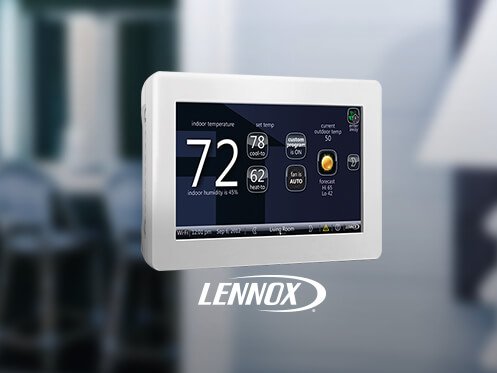
Your thermostat is the brain of your HVAC system, controlling the operation of the system’s components to sustain an ideal temperature for the interior of your home. However, making heads or tails of the settings and modes may seem confusing at times. If the owner doesn’t utilize this device properly, it can lead to less-than-effective system management. Take a few minutes to learn about your thermostat, and discover how to get the most from it.
What Your Thermostat Does
Your thermostat actually has two specific areas of control over for your HVAC system. Of course, you probably think about your system heating or cooling your home, and the thermostat does govern when these components operate.
However, your thermostat does more than just turn on and off the heating and cooling functions. It also controls the circulating fan, which draws air into your system and pushes it back out into your home.
Your thermostat has settings that must be set to control both of these functions. You must manage these controls in tandem to get the desired performance from your system.
Fan Settings
Regardless of the season, you’ll need to use your fan. The options typically include Auto and On. While On may seem like the reasonable option, this is actually the one that you’ll use less frequently.
When you turn the fan setting to On, it runs continuously, regardless of what the system is doing. This is perfect if you need to increase the circulation around your home, but that isn’t typically what you want to do.
Keep in mind that running your circulating fan continuously also reduces the service life of your air filter. The continuous flow of air through your system means your filter collects more contaminants, causing it to clog more quickly.
Continuous running also increases the wear on the circulating fan motor. While the motor is something a technician will service during routine maintenance, operating the fan nonstop will make it wear out more quickly.
Due to the considerable increase in operating and repair costs, most people choose to use the Auto function. This allows the thermostat to turn on the circulating fan while the air conditioner or heating system runs. You may have noticed that the fan turns on only after the internal components are ready to effectively condition the air.
While using Auto may reduce the wear on your circulating fan motor, it also limits the amount of air circulation. To provide some continual air movement, consider using ceiling or pedestal fans around your home. These fans help keep air moving and make the space more comfortable, independent of when your system runs. They are often less expensive to maintain or to replace, and they use less energy to run than your HVAC circulating fan.
Heating and Cooling Modes
The modes on your system allow you to set it to either Heat or Cool. This seems pretty straightforward. The Heat setting allows the furnace or heat pump to warm your house, and the Cool setting turns on the AC.
However, let’s dig a little more into how these modes actually control the temperature in your home. Inside your thermostat, there are internal controls that sense the temperature. In older thermostats, this would have been a little vial of liquid mercury that tilted when heated or cooled, opening or closing an electrical connection. It was an elegant mechanism, but modern thermostats are a bit more sophisticated.
Every thermostat has a temperature differential it senses, looking for a certain deviation from the set temperature. Once the thermostat recognizes that the temperature has hit this differential, the thermostat engages the appropriate system.
Older thermostats needed occasional calibration to prevent requiring large temperature swings to occur before engaging the system. However, newer models use all electrical sensors, and they need far less maintenance or calibration.
These newer models also keep the temperature much more consistent with much smaller temperature swings. Most modern thermostats should last about 10 years, and that’s roughly the life of the heating and cooling system. If you notice that you have temperature swings of more than a degree or two, it may be time to consider a new thermostat.
Understanding Holds
Once you have the fan and conditioning modes set, you need to set the temperature. When you do, most digital thermostats offer two hold settings for that temperature, either permanent or temporary.
The permanent hold means the system will maintain that temperature until you adjust it again. This can be helpful if you want to maintain a nearly constant temperature all the time. However, if you want to temporarily adjust your setting, a permanent hold may increase the likelihood of forgetting to reset it.
This is where the temporary hold becomes useful. Depending on your particular thermostat, the duration may vary, but thermostats usually have a maximum hold of about 12 hours. Check your owner’s manual to see the particulars of your model.
Some thermostats also offer a “Hold Until” option, which allows you to set the duration. This setting is perfect if you’re having a party or if you’re doing something you know will last for a specific period.
Program Options
The program settings on your digital thermostat are probably the most powerful tools you’ve been recently given to help control your energy usage and utility costs. The Department of Energy suggests adjusting your settings to vary by about seven to 10 degrees for eight hours a day. This is usually the interval when you aren’t home, and the strategy can save an estimated 10% on your annual costs.
Keep in mind that not all thermostats have the same program options. The simplest option is the weekly program. This allows you to set a daily schedule that will run every day of the week. Many of us have needs that vary over the weekend, so the weekly program isn’t sufficient.
This is when the 5-2 or 5-1-1 program options come in handy. The 5-2 option allows you to set a separate schedule for your weekdays and weekends.
However, if you have different schedules on Saturday and Sunday, you’ll want the 5-1-1 program capability. For even more control, you’ll want to look at a seven-day programmable thermostat. This allows you to have a different schedule for every day of the week.
Differences Between Programmable, Smart and Remote Access
Programmable thermostats can be cumbersome and confusing to try to set. If you have this experience, you may want to consider a smart-learning thermostat. These models learn your routine needs based on how you adjust the temperature at different times, and then they build a daily schedule from your habits.
For even more control, you may want to consider a remote access thermostat. These connect to your home’s comfort system to the Internet, allowing you to access the settings from your mobile device.
This is perfect if you’re running ahead of schedule or behind and if you want to adjust your settings on the fly. It also allows you to ensure that your settings are appropriate if you forget to adjust them before traveling.
Some smart thermostats also offer advanced controls for calibrating your system. These may include an offset feature for when you notice your thermostat reading above or below the actual temperature.
Beyer Air Conditioning & Heating has provided heating and cooling services to the people in and around San Antonio for more than 40 years. Our expert technicians provide reliable heating and cooling installation, maintenance, and repair along with air quality control solutions. Call to schedule your heating or cooling service with one of our experts today.



